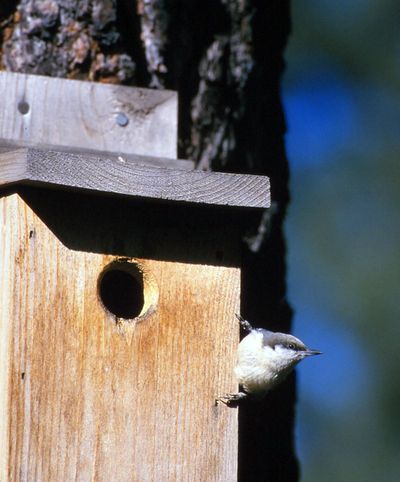Not too late to build nest boxes to welcome families of cavity-nesting birds

Although the nesting season for some birds such as geese and owls has been under way for more than a month, some species are still searching for sites to raise this season’s crop of chicks.
Some birds nest on the ground or in trees and under bridges. Other birds prefer tree cavities or other natural features, but will use man-made nest boxes when natural sites are scarce.
It’s not too late to build boxes for specific species. If it’s on your mind, do it now. At the least, you’ll be ready for next season.
Building nest boxes, or simply cleaning out boxes that already have been set out, are fun family projects that set the stage for observing bird families through the spring.
Nest box users in this area include flickers, woodpeckers, chickadees, nuthatches and wood ducks.
Migrants that winter in warmer climes have been returning to set up housekeeping in our backyards. Bluebirds, one of the most colorful nest-box users, are among the earliest to return.
These eye-pleasing birds also are among the most in need of a helping hand.
Bluebirds are secondary cavity nesters, meaning they rely on primary cavity nesters like woodpeckers to excavate and then abandon holes in trees. With trees becoming scarcer near open fields where bluebirds feed on insects, and competition is fierce for nest sites, bluebirds need all the help they can get.
Although not as showy, the house wren is another secondary cavity nester worth inviting into the yard.
The male house wren will build nests in several cavities and let his mate choose the one she likes best. The little male puts his heart into cramming sticks as long as 8 inches into the tiny nest box opening. He likes to leave a few inches of a stick protruding out the hole to discourage other nest-seeking birds.
The little birds will pay their rent by working daily to inspect the garden, including the stems, leaves, branches, ground cover and even the understructure of the roof in search of grubs, caterpillars and spiders.
While bluebirds were arriving in March, house wrens are just showing up around Spokane.
You don’t even have to be looking. Despite its tiny body, a house wren’s high-pitched rippling laugh is one of the cheeriest songs in the yard.
“You watch a male house wren and you can’t believe all that music can come out of such a little body,” local birder Jim Acton once told me. “He sings his fool head off.”
But any nest box won’t do for these special birds. Bluebirds, woodpeckers and other nest box birds have specific needs. The bigger the bird, the bigger the nest box needed.
Placement also can make a difference. Size and design of the opening are important to keep out competitive exotic species such as house sparrows.
Research has shown that a difference of a fraction of an inch in the diameter of a nest box hole can make a big difference in whether bluebirds succeed in fledging a family.